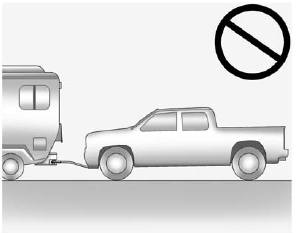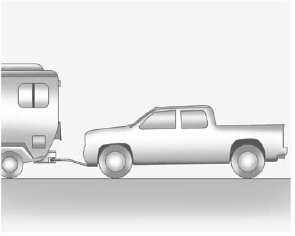Dinghy Towing

Two-Wheel-Drive Vehicles
Notice: If the vehicle is towed with all four wheels on the ground, the drivetrain components could be damaged.
The repairs would not be covered by the vehicle warranty. Do not tow the vehicle with all four wheels on the ground.
Two-wheel-drive vehicles should not be towed with all four wheels on the ground. Two-wheel-drive transmissions have no provisions for internal lubrication while being towed.

Four-Wheel-Drive Vehicles
Use the following procedure to dinghy tow a four-wheel-drive vehicle:
1. Position the vehicle being towed behind the tow vehicle and shift the transmission to P (Park).
2. Turn the engine off and firmly set the parking brake.
3. Securely attach the vehicle being towed to the tow vehicle.
WARNING
Shifting a four-wheel-drive vehicle's transfer case into N (Neutral) can cause the vehicle to roll even if the transmission is in P (Park). The driver or others could be injured. Make sure the parking brake is firmly set before the transfer case is shifted to N (Neutral).
4. Shift the transfer case to N (Neutral). See “Shifting into Neutral” under Four-Wheel Drive on page 9‑43 for the proper procedure to select the Neutral position for the vehicle.
5. Release the parking brake only after the vehicle being towed is firmly attached to the towing vehicle.
6. Turn the ignition to LOCK/OFF and remove the key—the steering wheel will still turn.
After towing, see “Shifting Out of Neutral” under Four-Wheel Drive on page 9‑43 for the proper procedure to take the vehicle out of the Neutral position.
See also:
XM Satellite Radio Service
XM is a satellite radio service based in the 48 contiguous United States and
10 Canadian provinces. XM Satellite Radio has a wide variety of programming and
commercial-free music, coast to coast, ...
FM Stereo
FM signals only reach about 16 to 65 km (10 to 40 mi). Although the radio has a built-in electronic circuit that automatically works to reduce interference, some static can occur, especially around ta ...
Air Conditioning
A/C (Air Conditioning): Press to turn the air conditioning on or off. If the
fan is turned off or the outside temperature falls below freezing, the air conditioning
will not work.
(Recirculation) ...





